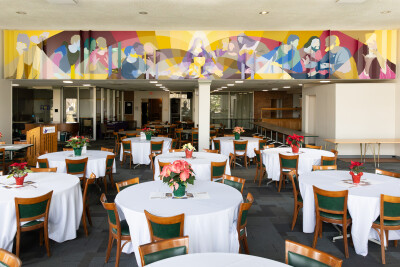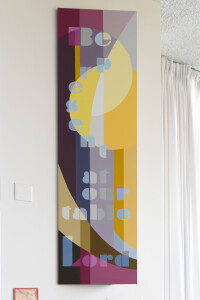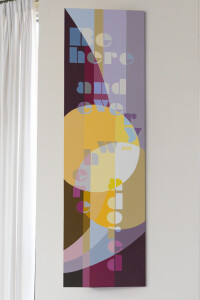New Last Supper highlights importance of spirituality and the arts
By Melissa Lauber
“An artist is not a special kind of person; every person is a special kind of artist.” These words of wisdom have guided the arts ministry of Catherine Kapikian, the founder of the Henry Luce III Center for Arts and Religion at Wesley Seminary. They have also served as a benediction for a recent service that celebrated the installation of her mural of the Holy Supper in the seminary’s refectory in early December.
These words of wisdom have guided the arts ministry of Catherine Kapikian, the founder of the Henry Luce III Center for Arts and Religion at Wesley Seminary. They have also served as a benediction for a recent service that celebrated the installation of her mural of the Holy Supper in the seminary’s refectory in early December.
Kapikian is a pioneer and a visionary, integrating the arts into the faith of United Methodists. The arts, she said, provide “meaning-making opportunities” to explore the mystery of how God reveals God’s self.”
Each person, she asserted, bears the divine image. “Creative capabilities are divinely given to every person as a birthright.
Summoning seminarians (and really everyone she meets) to awaken to wonder and the possibilities of creative expression was at the heart of all she did at Wesley. Her ministry was to restore the arts to the life of faith. She has retired from the seminary, but her own creative expression continues to be on display in hospitals, churches and other places where people gather around the nation.
 One of her newest creations, a painted mosaic of the Holy Supper, featuring 138 different colors, stretches across a 42x5 foot wall (a soffit) in the dining hall. It was installed in five panels and has 24 vertical pieces. When it’s all put together, it’s believed to weigh more than 500 pounds
One of her newest creations, a painted mosaic of the Holy Supper, featuring 138 different colors, stretches across a 42x5 foot wall (a soffit) in the dining hall. It was installed in five panels and has 24 vertical pieces. When it’s all put together, it’s believed to weigh more than 500 pounds
Kapikian drew her inspiration for the piece, which took more than two years and the assistance of a structural engineer and many seminarians to complete, from Leonardo DaVinci’s painting of the Last Supper in Milan. This Renaissance mural is one of the great works of early art history, Kapikian said, noting the beauty of the hands portrayed in the mural and the way it draws the viewer's focus inward to Christ.
“I wanted to do the opposite, and draw the focus outward,” she said. With exacting complexity, she drew upon the Fibonacci mathematical sequence, a predictable spiraling number sequence found in nature that expands to infinity. In this sequence, each number is the sum of the two preceding numbers.
With countless small pieces of paper, Kapikian plotted the sequence of shapes that would emanate from the Communion cup. It was, she believed an apt metaphor for the Eucharist.
For two and a half years, from inspiration, through pattern making, design, painting and execution of her creation, Kapikian drew upon her “participatory aesthetic” and invited others and the presence of the Holy Spirit to share in the creative process.
On columns near the work, Kapikian also created matching panels that hold the words to a prayer: “Be Present at our Table, Lord; Be Here and Everywhere Adored.” These words, and a large clock, were what graced the wall before Kapikian’s artwork was mounted.


While, as an artist, she leaves the judgment of her work to others, Kapikian did claim she found it “definitely a better theological alternative to that clock.”
Retired from the seminary, Kapikian continues as a working artist, and her work continues to explore spiritual themes, even as she continues to encourage others to engage in creative expression. “There is a deep correspondence between the creative process and spirituality,” she said. “It connects us into that centermost part of our being that comes from God. It allows the numinous, the divine, the holy – what you call that – to break into your life.”
See a video of the Oxnam Chapel worship service and Kapikian’s comments, which preceded the celebration of The Last Supper mural on Dec. 5.

